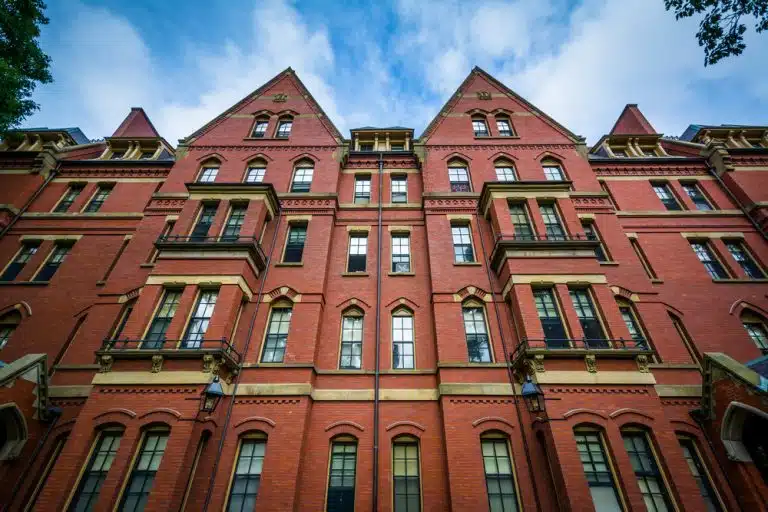When you think of Harvard, you might imagine an iconic, sprawling campus filled with brilliant students and world-class professors. But what does that really mean in numbers? From the size of the campus to the student population and average class sizes, there’s a lot to uncover.
Let’s break down how big Harvard University is in every sense—academics, campus, community, and even alumni influence. If you’re considering applying or just curious about what makes Harvard tick, we’ve got all the details you need to get a sense of just how expansive Harvard can be.
- How Big Is Harvard’s Campus?
- How Big Is Harvard’s Student Body?
- Harvard Class Demographics
- Harvard Class Size: What Can You Expect?
- How Big Is Harvard’s Campus Life?
- How Big Is Harvard’s Alumni Network?
- Frequently Asked Questions
- Takeaways
How Big Is Harvard’s Campus?
To get a sense of how big Harvard really is, let’s start with the physical campus. Harvard University, located in Cambridge, Massachusetts, spans about 5,667 acres, which includes all of its schools and facilities.
The main campus, where Harvard College and many iconic buildings are located, takes up about 209 acres. This area has everything from academic buildings and dorms to green spaces like Harvard Yard, plus plenty of recreational facilities and libraries.
Harvard Yard
Harvard Yard, often called the heart of Harvard, is a 25-acre green space that houses several first-year dormitories, including Massachusetts Hall (the oldest surviving building on campus) and Weld Hall. You’ll also find University Hall, which contains key administrative offices. Harvard Yard is an essential hub for student life, where events and gatherings are frequently held.
The main campus is also home to their iconic academic buildings. Sever Hall, for instance, is one of the main spots for undergrad lectures, while Emerson Hall is home to the Philosophy Department. The Harvard Science Center is where math, computer science, and natural sciences students hang out, with modern labs and lecture halls to support their studies.
Harvard libraries and museums
Widener Library, a landmark on campus, is part of Harvard’s extensive library system, which is the largest academic library system in the world. Widener Library alone holds over 3.5 million books, but it is just one of over 70 libraries available to students.
Other well-known libraries include Lamont Library, a favorite study spot for undergrads with extended hours, and Cabot Science Library, located in the Science Center, which is great for group study sessions.
Besides academic spaces, the Harvard Art Museums—like the Fogg, Busch-Reisinger, and Arthur M. Sackler museums—give you access to over 250,000 works of art. The Sanders Theatre is another important building. It serves as both a lecture hall and a venue for concerts and performances.
Harvard recreational and residential facilities
Harvard’s recreational facilities are also impressive. The Malkin Athletic Center (MAC) serves as the primary fitness center. It features swimming pools, weight rooms, and group exercise studios. Blodgett Pool is home to Harvard’s varsity swimming and diving teams, and Harvard Stadium, with a seating capacity of over 30,000, is the nation’s oldest stadium built specifically for football.
The residential aspect of how big Harvard is also important to understanding the campus. First-year students live in dormitories around Harvard Yard, while upperclassmen live in one of the 12 residential houses such as Kirkland House, Eliot House, or Dunster House. Each house has its own dining hall, library, and unique common spaces.
How Big Is Harvard’s Student Body?
Another aspect of how big Harvard is is its student body size. Harvard University has over 25,000 students, which includes undergraduate, graduate, and professional students. Harvard College, which is the undergraduate school, enrolls approximately 7,000 students.
Harvard’s smaller student population helps create a strong sense of community. Like other Ivy League schools, its student body is smaller compared to big public universities. For example, Princeton University has over 5,600 students, which is similar to Harvard’s relatively smaller size. This is partly because of the competitive admissions process and low acceptance rate.
Because of this, you’ll often get to know your peers personally, whether it’s through classes, clubs, or living in the dorms. Even though Harvard is famous worldwide, the campus has a close-knit feel that you’ll really appreciate.
Harvard Class Demographics
So, what are the Harvard class demographics like? Harvard takes a lot of pride in admitting a diverse group of students, and it definitely shows in the freshman class. Students come from all 50 states and over 100 countries, bringing a huge variety of cultural, social, and academic backgrounds.
Around 17% of the class is Asian American, 16% is African American, 12% is Hispanic or Latino, and about 3% identify as Native American or Pacific Islander. In total, about 45% of students are people of color, which gives Harvard a really wide mix of backgrounds.
On top of that, about 20% of the freshman class are first-generation college students, which means they’re the first in their families to go to college. This really highlights Harvard’s efforts to make higher education more accessible to everyone. Plus, international students make up around 15% of the class, coming from all over the world.
This kind of diversity is a big part of what makes the Harvard experience so special. You get to learn from your professors and also from your classmates who all bring different perspectives and experiences. From class discussions, campus events, to just hanging out in your residential house, the range of backgrounds helps create a community where everyone has something unique to offer.
Harvard Class Size: What Can You Expect?
If you’re wondering how big Harvard is in terms of its classes, you might be surprised by how personalized the academic experience is. One of the unique features of Harvard is its commitment to keeping class sizes small to enhance learning. The Harvard class size tends to vary depending on the subject, but most classes are intentionally kept small to promote interaction between students and professors.
With a 7:1 student to faculty ratio, you’ll get the chance to participate, ask questions, and really engage with the material. On average, Harvard’s class size is around 12 students per class. More than 75% of courses have fewer than 20 students, and only about 10% of classes have more than 50 students.
When looking at how big Harvard is, another important metric is the freshman class. The Harvard University freshman class size is around 1,900 students each year. This number makes sure that incoming students can get to know each other and integrate into the university community.
How Big Is Harvard’s Campus Life?
When thinking about how big Harvard is, it’s also about the huge variety of student organizations. With over 400 clubs and groups to choose from, Harvard feels pretty big when it comes to opportunities for getting involved.
Here’s a look at some of the most popular clubs and organizations at Harvard:
- The Harvard Crimson. If you’re into journalism, you can join Harvard’s student-run daily newspaper, where you’ll get hands-on experience in reporting, editing, and publishing.
- Harvard-Radcliffe Dramatic Club (HRDC). HRDC is the place to be if you love theater. They put on lots of plays and musicals throughout the year.
- Harvard Model United Nations (HMUN). Interested in international relations? HMUN is one of the largest and oldest model UN programs. The organization lets you get into diplomacy and global issues.
- The Harvard College Consulting Group (HCCG). If you want to try consulting, HCCG lets you work on real projects with actual clients, which gives you practical experience in business and strategy.
- Phillips Brooks House Association (PBHA). If you’re passionate about giving back, PBHA is Harvard’s biggest public service group. It offers tons of programs in tutoring, mentoring, and social justice.
These are just a few examples of what Harvard has to offer. No matter what you’re into, the vibrant extracurricular scene makes sure that you’ll find ways to get involved and make your time at Harvard memorable.
How Big Is Harvard’s Alumni Network?
When people ask how big Harvard is, they’re often not just talking about the campus. They’re probably also curious about how far Harvard’s reach extends worldwide. Harvard’s alumni network is massive, with over 400,000 members worldwide.
Here are some Harvard alumni who have made a huge impact in different fields:
- Barack Obama. 44th President of the United States and a Harvard Law School graduate. His time at Harvard helped build the network and connections that supported his political career.
- Mark Zuckerberg. Co-founder and CEO of Facebook (now Meta). Zuckerberg launched Facebook while he was at Harvard, and though he didn’t graduate, the support and collaboration he found at Harvard were crucial to his success.
- Natalie Portman. Oscar-winning actress who graduated from Harvard with a degree in Psychology. She often credits her Harvard experience with expanding her interests beyond acting.
- Sheryl Sandberg. Former COO of Facebook and author of “Lean In.” She’s been a major figure in tech and women’s leadership, and her connections from both Harvard College and Harvard Business School have been a big part of her journey.
- Bill Gates. Co-founder of Microsoft, who started at Harvard before leaving to build his business. Gates still has strong ties to Harvard and collaborates on various philanthropic projects with the university.
Being part of Harvard’s alumni network opens a lot of doors. There are over 200 Harvard Clubs around the world that connect alumni through events, conferences, and mentorship opportunities. This means that wherever you end up after graduation, there will be Harvard alums who can help you, whether it’s through career advice, mentorship, or just sharing their experiences.
The alumni network is one of the big reasons Harvard grads are so successful. The majority—around 58%—of Harvard’s Class of 2024 went straight into the workforce, and more than half of them landed jobs in finance, tech, or consulting. Two in five seniors starting jobs are making six-figure salaries right out of the gate.
On top of that, about 21% of the Class of 2024 will continue on to grad or professional schools. Another 10% are planning to do fellowships, which is up from 6% last year, while 8% are still figuring out their next steps. That means around 89% of graduates in total will be occupied with either work, further education, or fellowships right after graduation.
These are just a few examples of the kind of impact Harvard alumni have made. If you’re aiming for a career in politics, tech, business, or the arts, Harvard’s alumni network has your back. Being part of such a large and successful community really shows how big Harvard is—not just in terms of its campus or number of students, but in the global impact its graduates are making.
Frequently Asked Questions
1. What is the average class size at Harvard University?
The average class size at Harvard University is around 12 students per class. Harvard emphasizes small class sizes to ensure more personalized attention from professors and active student participation. In fact, over 75% of classes have fewer than 20 students, which creates a collaborative and engaging learning environment.
2. What is the student-to-faculty ratio at Harvard University?
The student-to-faculty ratio at Harvard University is 7:1. This low ratio allows for more personalized interaction between students and professors. It provides opportunities for mentorship, guidance, and in-depth discussions.
3. What are Harvard class demographics like?
The Harvard class demographics are diverse and reflect Harvard’s commitment to admitting students from a wide range of backgrounds. About 17% of students are Asian American, 16% are African American, 12% are Hispanic or Latino, and nearly 3% identify as Native American or Pacific Islander. Around 15% of students are international, and about 20% are first-generation college students.
4. Does Harvard look at freshman grades?
Yes, Harvard does look at freshman grades as part of their holistic review process. They evaluate your entire high school transcript, so it’s important to perform well throughout all four years. The average GPA of admitted students is typically 4.2, which means most successful applicants have nearly perfect grades in rigorous coursework.
5. What is the Harvard University freshman class size?
The Harvard University freshman class size is around 1,900 students each year. This smaller size helps incoming students build strong relationships and integrate into the university community. It allows for more personalized academic and social experiences as students get to know each other better.
Takeaways
So, how big is harvard? Here are the key takeaways that highlight everything from its campus and class size to its incredible community and global reach:
- Harvard’s campus spans about 5,667 acres, with the main campus in Cambridge covering roughly 209 acres, including academic buildings, residential halls, green spaces, libraries, and more.
- In terms of student population, how big Harvard is can be seen through its 7,000 undergraduates and 31,000 total students, which gives it a more close-knit feel compared to larger public universities.
- Harvard’s impact also extends to its alumni network, with over 400,000 alumni worldwide who provide support, mentorship, and career opportunities across various fields.
- With over 400 student organizations, Harvard’s size is also about the opportunities it offers. You’ll find plenty of ways to get involved no matter your interest.
- The average Harvard class size is just 12 students, which means you’ll get personalized attention, more interaction with professors, and a collaborative learning experience.
- Eager to get into Harvard? A college admissions consultant can provide personalized and expert advice to make it happen. Let AdmissionSight get you into a school that’s as big as your dreams.





